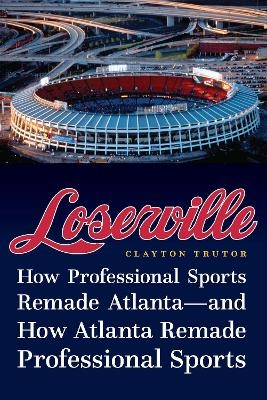
Loserville
University of Nebraska Press (Verlag)
978-1-4962-2504-7 (ISBN)
- Lieferbar
- Versandkostenfrei
- Auch auf Rechnung
- Artikel merken
2023 Bell Award for the Best Book on Georgia History
A Sports Collectors Digest Best Baseball Book of 2022
A Public Books Public Pick of 2022
In July 1975 the editors of the Atlanta Constitution ran a two-part series entitled “Loserville, U.S.A.” The provocatively titled series detailed the futility of Atlanta’s four professional sports teams in the decade following the 1966 arrival of its first two major league franchises, Major League Baseball’s Atlanta Braves and the National Football League’s Atlanta Falcons. Two years later, the Atlanta Hawks of the National Basketball Association became the city’s third major professional sports franchise. In 1972 the National Hockey League granted the Flames expansion franchise to the city, making Atlanta the first southern city with teams in all four of the big leagues.
The excitement surrounding the arrival of four professional franchises in Atlanta in a six-year period soon gave way to widespread frustration and, eventually, widespread apathy toward its home teams. All four of Atlanta’s franchises struggled in the standings and struggled to draw fans to their games. Atlantans’ indifference to their new teams took place amid the social and political fracturing that had resulted from a new Black majority in Atlanta and a predominately white suburban exodus. Sports could never quite bridge the divergence between the two.
Loserville examines the pursuit, arrival, and response to professional sports in Atlanta during its first decade as a major league city (1966–75). It scrutinizes the origins of what remains the primary model for acquiring professional sports franchises: offers of municipal financing for new stadiums. Other Sunbelt cities like San Diego, Phoenix, and Tampa that aspired to big league stature adopted Atlanta’s approach. Like the teams in Atlanta, the franchises in these cities have had mixed results—both in terms of on-field success and financial stability.
Clayton Trutor holds a PhD in U.S. history from Boston College and teaches at Norwich University in Northfield, Vermont. He writes about college football and basketball for SB Nation. Trutor is also the Vermont state chairman of the Society for American Baseball Research (SABR) and is a regular contributor to the SABR Biography Project.
List of Illustrations
Acknowledgments
Introduction
1. Forward Atlanta
2. America’s Virgin Sports Territory
3. Franchise Free Agency
4. The Greatest Location in the World
5. Wisconsin v. Milwaukee Braves
6. Gravitating toward Atlanta
7. Not Catching On around Town
8. Losing but Improving
9. Atlanta Stadium, a Center of Gravity
10. Outside the Stadium It’s the City
11. Atlanta Stadium, a Meeting Place
12. Madison Square Garden of the Southeast
13. The Developer Is Boss
14. The Politics of Metropolitan Divergence
15. Probably Room for Basketball
16. The Logical Choice
17. How the Falcons Lost Atlanta
18. Atlanta’s Ice Society
19. Just What Atlanta Needs
20. I Think the Fans Showed Poor Taste
21. Instant City
22. Keep Hockey a Southern Sport
23. Loserville No More
24. How the Sunbelt Became Loserville, U.S.A.
Notes
Bibliography
Index
| Erscheinungsdatum | 02.02.2022 |
|---|---|
| Zusatzinfo | 12 photographs, index |
| Verlagsort | Lincoln |
| Sprache | englisch |
| Maße | 152 x 229 mm |
| Themenwelt | Sachbuch/Ratgeber ► Geschichte / Politik ► Allgemeines / Lexika |
| Sachbuch/Ratgeber ► Geschichte / Politik ► Regional- / Landesgeschichte | |
| Geisteswissenschaften ► Geschichte ► Regional- / Ländergeschichte | |
| Weitere Fachgebiete ► Sportwissenschaft | |
| ISBN-10 | 1-4962-2504-X / 149622504X |
| ISBN-13 | 978-1-4962-2504-7 / 9781496225047 |
| Zustand | Neuware |
| Haben Sie eine Frage zum Produkt? |
aus dem Bereich


